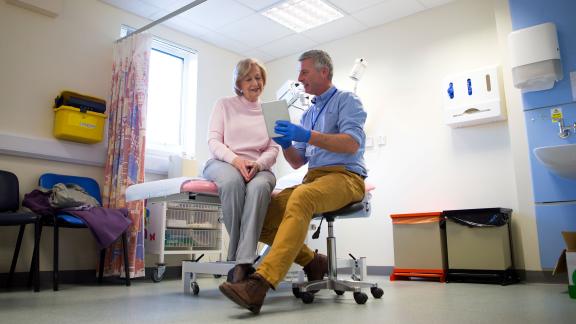Recognising autonomous practice for SAS doctors and dentists

Overview
Stockport NHS Trust worked with national stakeholders to create a local policy which enabled autonomous SAS doctors and dentists to clinically code work in their own name, resulting in more accurate data.
Key benefits and outcomes
- Improved workforce intelligence.
- Design and implementation of new local policy.
- Enhanced visibility of SAS doctors and dentists.
What the organisation faced
Each time a patient attends hospital; the information is entered into hospital software with a standardised coding system. This information is then used for various purposes, including billing, planning and research.
All clinical work is assigned to a named doctor, this is usually the person that treats the patient or has overall responsibility for them, such as a consultant. Senior SAS doctors are typically autonomous practitioners, however, the way the coding system is setup, means that the SAS doctor is not the named clinician during the coding process.
Coding correctly is important to a clinician as they use this data to measure their individual performance, highlighting any areas of practice which may require improvement and demonstrate their clinical competencies.
Stockport NHS Trust found that a lot of its SAS workforce is working autonomously but don’t have the option to code work in their name because of the functionality within the NHS Digital Commissioning Data Sets (CDS) dictionary. This practice fails to reflect the reality of service delivery in many trusts, where experienced SAS doctors are independently managing clinics and procedures. As a result, their contributions are often attributed to consultants, undermining SAS doctors’ professional recognition and preventing accurate workforce planning.
What the organisation did
Stockport’s SAS tutor, Professor Shashidhara investigated the issues surrounding clinical coding. The organisation ran a survey and met with several SAS doctors to discuss what could be done to maximise the services using the skills held among the SAS doctor workforce. The trust reviewed theatre lists and different specialties before delving deeper into autonomous roles by looking at current processes and how these worked, with a particular focus on why SAS doctors were not able to be coded for their work. The trust wanted to make sure that every SAS doctor, could work autonomously at some stage of their career and be recognised for this.
Clinical coding was discussed with the trust’s business managers who acknowledged the need for coding to accurately reflect the actual delivery of care. The trust developed a data collection form for SAS doctors to complete, which was then reviewed against their real clinical activity. This process confirmed that SAS doctors were delivering significant amounts of autonomous care. It was therefore agreed that clinical coding should be updated to align with what was happening in practice, particularly given the shortage of consultants to cover services. This ensured that the work of SAS doctors was properly recognised and recorded.
The trust collaborated with NHS Digital, the British Medical Association (BMA) and the General Medical Council (GMC) along with other workforce colleagues to identify how they could ensure that SAS doctors could clinically code their work.
With the support from national stakeholders, the trust identified a way to update its digital framework. By outlining a local mechanism and creating a new policy to define and assess the SAS doctors’ work as partially or fully autonomous, a new version of Digital CDS allowed SAS doctors to code their work by allowing GMC numbers to be recorded under the ‘consultant code’ field formally attributing care to the responsible clinician, regardless of grade.
Results and benefits
SAS doctors at Stockport now have their autonomous practice recorded, which has boosted morale and led to SAS doctors feeling valued and recognised. It has improved the accuracy of workforce data and increased access to independent clinic slots and procedure lists which has benefited patient care.
As the SAS development programme lead for NHS England North West, Professor Shashidhara has been able to visit multiple conferences and share best practice with colleagues and advising trusts how to do the same.
Overcoming obstacles
Implementing a different working style came with some challenges. It was key to engage with wider stakeholders to highlight the positive improvements a new working style would bring. The trust expressed the importance of investing time and effort in recognising the invaluable contributions of SAS doctors, who provide essential services and lead teams with autonomy, accountability and dedication. It’s crucial to develop effective mechanisms that value, reward and recognise the pivotal role that SAS doctors play in delivering safe, high-quality patient care, ensuring their leadership and unwavering commitment are fully acknowledged and supported.
Take-away tips
- Early engagement with the SAS workforce to describe the benefits and understand any concerns about changing the way clinical coding works.
- Leadership sets the tone for transformation, and support from senior executives is crucial.
Contact
Stockport SAS Administration Team sas@stockport.nhs.uk



